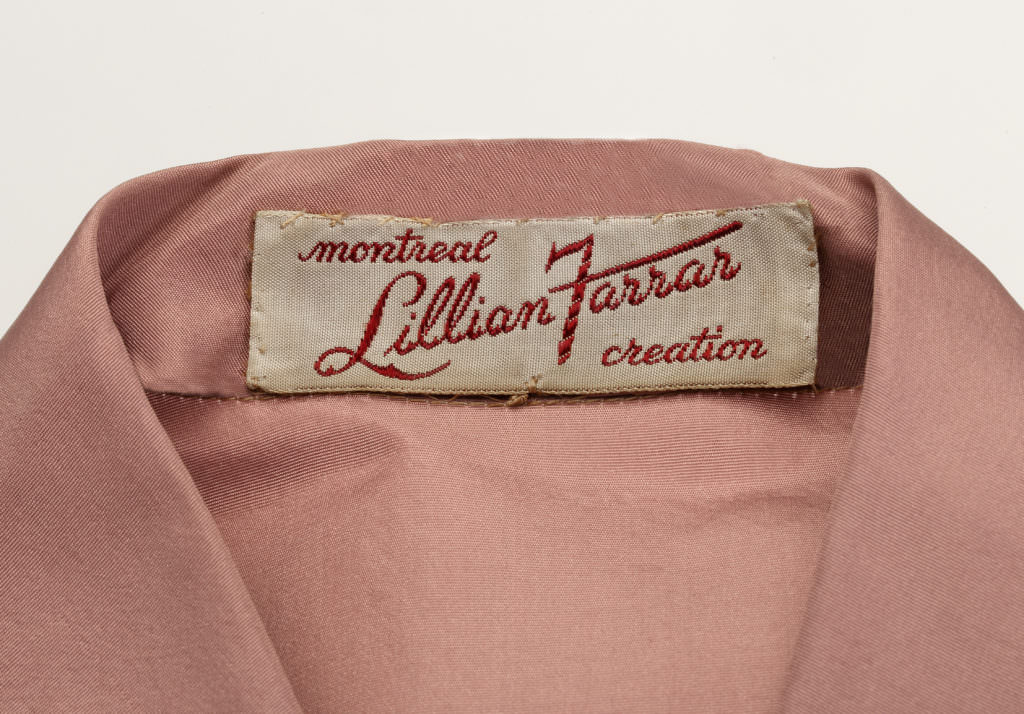Born in 1911 or 1912 in Iberville, Quebec, Lillian Farrar was one of six children of Georges and Blanche Farrar. Her father worked as a designer of needlework patterns sold through newspapers. At the age of 15, Lillian purchased her first sewing machine on installment and began making clothing for neighbours. At the age of 18, she moved to Montreal and began working in a garment factory on St. Lawrence Boulevard. After saving up $300, Farrar quit her factory job and began to design and sell dresses out of her rented room on St. Joseph Boulevard, hiring a pattern maker to teach her basic skills, which she applied to her practice. After two years of making dresses in this way, she was able to live as a permanent resident at the Ritz-Carlton hotel. She was first listed as a dressmaker in a 1940 city directory, at a Sherbrooke Street West address. In 1946, she moved into her four-storey salon at 2021 Peel Street, purchasing it five years later.
In 1951, Farrar was commissioned by the citizens of Campbellford, Ontario, to create a coat for Princess Elizabeth to wear on her vacation in the Laurentians.
The cape was of English wool fleece in a canary yellow and black diagonal weave. Although Farrar favoured wools and silks over synthetics, in 1954 she accepted an invitation to be the first Canadian to endorse Terylene and create garments from the fabric. Her horizontally-striped strapless evening gown was featured in a Terylene ad in Chatelaine magazine.

Dress (detail), Lillian Farrar, 1956. Gift of Marie-Anne Brossard, M2010.110.2 © McCord Museum
In 1957, a lengthy feature article in Maclean’s magazine described Farrar as “a vigorous, red-headed woman in her late forties with a unique blend of talent and independence that have made her one of the richest dressmakers in Montreal.” Farrar was known for her design talent and her original clothing, which mirrored fashionable silhouettes but did not follow specific trends. She described herself as “a combination of an engineer and a psychologist” because of the way she would take inspiration from the fabric and each client’s personality and figure to create a garment. She was also widely known for her feisty character. According to Maclean’s, she could “insult her richest patrons, scorn Paris, insist men have better taste than women, and tell customers they’re wrong. But they just keep coming back for more.” “When you feel responsible for your customers’ appearance, you’ve got to be frank,” Farrar stated unapologetically.
In the 1950s, her clientele consisted of a diverse roster of around 400 women, willing to pay between $135 and $400 for a dress that was most often not what they came in asking for, but what Farrar determined was suitable for them.
While many of her clients were indeed wealthy socialites, TV and radio personalities, and wives of successful lawyers and doctors, Farrar’s early experiences made her sympathetic to working women whom she allowed to pay for their garments in weekly installments.
Clients were served in her first floor showroom with dark green carpeting, light grey walls with oval mirrors and dark polished tables with white-shaded lamps, and greeted by assistant Eugénie Dubé, Farrar’s childhood friend. Dubé was also credited with “looking after the books, making appointments, serving coffee, listening to customers’ small talk, and soothing ruffled feelings.” Farrar might be ushered in to meet the client from her miniscule 5-foot square office at the back, although she was constantly on the move supervising all aspects of the business. The workshops on the upper floors of the building had stations for 25 seamstresses and cutter Norman Watanabe, as well as Farrar’s design studio, which she called “the snake-pit.”
In that part of the space, Farrar would take bolts of fabric and design garments around what she referred to as the “story” they told her.
She claimed that this process could take her as little as two minutes, although she was active in every step of the fabrication process, making modifications as garments materialized and clients tried them on.
In 1967, Farrar opened a boutique on her ground floor where customers did not have to make an appointment to buy clothes. The boutique remained open as “Lillian Farrar Haute Couture” until about 1971.
Sources
“Canada Designed Cape Coat for Princess Elizabeth.” Women’s Wear Daily, November 6, 1951.
“Farrar, Miss Lillian “. In Annuaires Lovell, edited by Annuaires Lovell. Montreal, QC: Lovell Publishing, 1970-1971.
“Farrar, Miss Lillian Prop Haute Couture.” In Annuaires Lovell, edited by Annuaires Lovell, 27. Montreal, QC: Lovell Publishing, 1969-1970.
Gougeon, Helen. “She Tells Them What They Want.” The Ottawa Citizen, Weekend Picture Magazine, April 3, 1954, 14-17, 28.
Laurier, Marie. “Collections Défilent…” La Presse, October 13, 1961, 10.
“Pour Vous Mesdames.” La Presse, July 8, 1925, 4.
Robert, Marie. “Entre Nous.” La Presse, April 27, 1967, 32.
Sangster, Dorothy. “She Sells Glamour with a Growl.” MacLean’s, March 30, 1957, 5.
“Sixth Census of Canada, 1921.” edited by Dominion of Bureau of Statistics. Ottawa, Ontario: Library and Archives Canada, 1921.
“Terylene.” Chatelaine, June 1954.






